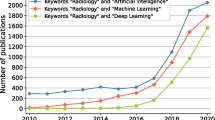Abstract
There is recent popularity in applying machine learning to medical imaging, notably deep learning, which has achieved state-of-the-art performance in image analysis and processing. The rapid adoption of deep learning may be attributed to the availability of machine learning frameworks and libraries to simplify their use. In this tutorial, we provide a high-level overview of how to build a deep neural network for medical image classification, and provide code that can help those new to the field begin their informatics projects.
Similar content being viewed by others
Avoid common mistakes on your manuscript.
Introduction
Machine learning has sparked tremendous interest over the past few years, particularly deep learning, a branch of machine learning that employs multi-layered neural networks. Deep learning has done remarkably well in image classification and processing tasks, mainly owing to convolutional neural networks (CNN) [1]. Their use became popularized after Drs. Krizhevsky and Hinton used a deep CNN called AlexNet [2] to win the 2012 ImageNet Large Scale Visual Recognition Challenge (ILSVRC), an international competition for object detection and classification, consisting of 1.2 million everyday color images [3].
The goal of this paper is to provide a high-level introduction into practical machine learning for purposes of medical image classification. A variety of tutorials exist explaining steps to use CNNs, but the medical literature currently lacks a step-by-step source for those practitioners new to the field in need of instructions and code to build and test a network. There are many different libraries and machine learning frameworks available, including Caffe, MXNet, Tensorflow, Theano, Torch and PyTorch, which have facilitated machine learning research and application development [4]. In this tutorial, we chose to use the Tensorflow framework [
Some examples of transformed images are presented on Fig. 6.
Then, more instructions are provided to the generator, such as training directory containing the files, size of images, and batch size (Fig. 7). Then, we fit the model into the generator, which is the last set of code to run the model (Fig. 7).
Training the Model
After executing the code in Fig. 7, the model begins to train (Fig. 8). In only five epochs, the training accuracy equals 89% and validation accuracy 100%. The validation accuracy is usually lower than the training accuracy, but in this case, it is higher likely because there are only 10 validation cases. The training and validation loss both decrease, which indicates that the model is “learning.”
The loss and accuracy values are stored in arrays, which can be plotted using Matplotlib (Fig. 9), which is a Python plotting library that produces figures in a variety of formats.
Evaluating the Trained Model
In addition to inspecting training and validation data, it is common to evaluate the performance of the trained model on additional held-out test cases for a better sense of generalization. In Keras, one could use the data generator on a batch of test cases, use a for-loop on an entire directory of cases, or evaluate one case at a time. In this example, we simply do inference on two cases and return their predictions (Figs. 10 and 11). The outputs from such could also be used to generate a receiver operating characteristic (ROC) curve using Scikit learn, a popular machine learning library in Python, or separate statistical program.
Conclusion
With only 65 training cases, the power of transfer learning and deep neural networks, we built an accurate classifier that can differentiate chest vs. abdominal radiographs with a small amount of code. The availability of frameworks and high-level libraries has made machine learning more accessible in medical imaging. We hope that this tutorial provides a foundation for those interested in starting with machine learning informatics projects in medical imaging.
Data Availability
The Jupyter Ipython Notebook containing the code to run this tutorial is available on the public SIIM Github repositiory: https://github.com/ImagingInformatics/machine-learning, under “HelloWorldDeepLearning.” A live interactive demo to the model is available at https://public.md.ai/hub/models/public.











